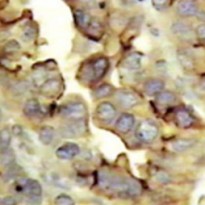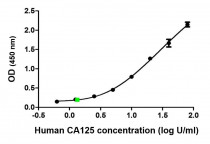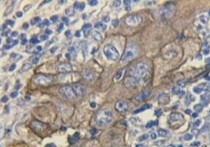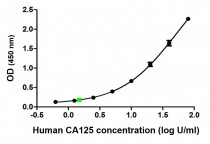ARG10351
anti-MUC16 / CA125 antibody [X325]
anti-MUC16 / CA125 antibody [X325] for ELISA,IHC-Formalin-fixed paraffin-embedded sections,Western blot and Human
Cancer antibody; Controls and Markers antibody; Signaling Transduction antibody
Overview
| Product Description | Mouse Monoclonal antibody [X325] recognizes MUC16 / CA125 |
|---|---|
| Tested Reactivity | Hu |
| Tested Application | ELISA, IHC-P, WB |
| Host | Mouse |
| Clonality | Monoclonal |
| Clone | X325 |
| Isotype | IgG1 |
| Target Name | MUC16 / CA125 |
| Antigen Species | Human |
| Immunogen | MUC16 / CA125 antigen purified from human ovarian carcinoma |
| Conjugation | Un-conjugated |
| Alternate Names | Mucin-16; MUC-16; Ovarian carcinoma antigen CA125; CA125; Ovarian cancer-related tumor marker CA125; CA-125 |
Application Instructions
| Application Suggestion |
|
||||||||
|---|---|---|---|---|---|---|---|---|---|
| Application Note | Sandwich ELISA (Capture antibody - Detection antibody): ARG10156 - ARG10351 ARG10351 - ARG10156 ARG10534 - ARG10351 * The dilutions indicate recommended starting dilutions and the optimal dilutions or concentrations should be determined by the scientist. |
Properties
| Form | Liquid |
|---|---|
| Purification | Ion exchange chromatography. |
| Buffer | 10 mM Tris (pH 7.5), 0.15 M NaCl and 0.05% Sodium azide |
| Preservative | 0.05% Sodium azide |
| Concentration | 1.0-2.0 mg/ml |
| Storage Instruction | For continuous use, store undiluted antibody at 2-8°C for up to a week. For long-term storage, aliquot and store at -20°C or below. Storage in frost free freezers is not recommended. Avoid repeated freeze/thaw cycles. Suggest spin the vial prior to opening. The antibody solution should be gently mixed before use. |
| Note | For laboratory research only, not for drug, diagnostic or other use. |
Bioinformation
| Database Links | |
|---|---|
| Gene Symbol | MUC16 |
| Gene Full Name | mucin 16, cell surface associated |
| Background | CA125 is a tumor antigen widely used in monitoring ovarian cancer. Using a rabbit polyclonal antibody produced to purified CA125 antigen to screen cells from an ovarian cancer cell (OVCAR-3) cDNA library in E. coli, Yin and Lloyd (2001) cloned a long partial cDNA, which they designated MUC16, corresponding to the CA125 antigen. The deduced 1,890-amino acid protein contains characteristic features of a mucin-type molecule, including a high serine, threonine, and proline content in an N-terminal region of 9 partially conserved tandem repeats and a C-terminal region nontandem repeat sequence containing a possible transmembrane region and a potential tyrosine phosphorylation site. MUC16 also has a high leucine content. Northern blot analysis showed that the level of MUC16 mRNA correlated with the expression of CA125 in a panel of cell lines. [Provide by OMIN] |
| Function | Thought to provide a protective, lubricating barrier against particles and infectious agents at mucosal surfaces. [UniProt] |
| Research Area | Cancer antibody; Controls and Markers antibody; Signaling Transduction antibody |
| Calculated MW | 1519 kDa |
| PTM | Heavily O-glycosylated; expresses both type 1 and type 2 core glycans. Heavily N-glycosylated; expresses primarily high mannose and complex bisecting type N-linked glycans. May be phosphorylated. Phosphorylation of the intracellular C-terminal domain may induce proteolytic cleavage and the liberation of the extracellular domain into the extracellular space. May contain numerous disulfide bridges. Association of several molecules of the secreted form may occur through interchain disulfide bridges providing an extraordinarily large gel-like matrix in the extracellular space or in the lumen of secretory ducts. |
Images (5) Click the Picture to Zoom In
-
ARG10351 anti-MUC16 / CA125 antibody [X325] IHC-P image
Immunohistochemistry: Paraffin-embedded Human lung adeno-carcinoma tissue stained with ARG10351 anti-MUC16 / CA125 antibody [X325].
-
ARG10351 anti-MUC16 / CA125 antibody [X325] standard curve image
ELISA: Analysis of Human CA125 expression using ARG10156 anti-MUC16 / CA125 antibody [X75] as a capture antibody and biotinylated ARG10351 anti-MUC16 / CA125 antibody [X325] as a detection antibody with purified Human CA125 as antigen to generate the standard curve. Detection is by HRP conjugated streptavidin and substrate. Plasma (green) sample at 1:2 is shown.
-
ARG10351 anti-MUC16 / CA125 antibody [X325] IHC-P image
Immunohistochemistry: Paraffin-embedded Human serosal ovarian adenocarcinoma tissue stained with ARG10351 anti-MUC16 / CA125 antibody [X325].
-
ARG10351 anti-MUC16 / CA125 antibody [X325] IHC-P image
Immunohistochemistry: Paraffin-embedded Human urinary bladder adenocarcinoma tissue stained with ARG10351 anti-MUC16 / CA125 antibody [X325].
-
ARG10351 anti-MUC16 / CA125 antibody [X325] standard curve image
ELISA: Analysis of Human CA125 expression using ARG10351 anti-MUC16 / CA125 antibody [X325] as a capture antibody and biotinylated ARG10156 anti-MUC16 / CA125 antibody [X75] as a detection antibody with purified Human CA125 as antigen to generate the standard curve. Detection is by HRP conjugated streptavidin and substrate. Plasma (green) sample at 1:2 is shown.
Clone References












